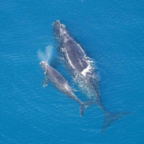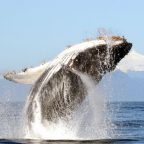
A groundbreaking new online tool called Whale Safe has been created by marine scientists and top whale researchers from across the country, including Texas A&M University at Galveston’s Dr. Ana Širović. The tool allows users to detect the endangered animals in order to mitigate vessel strikes and increase conservation efforts of the endangered marine species.
Displaying near real-time data to help prevent ships and whales from colliding, Whale Safe is an analysis and mapping tool designed to lessen the chance of a strike or collision. The interactive web tool is the result of three years of work between scientists and researchers from Texas A&M-Galveston, Woods Hole Oceanographic Institution, the National Oceanic and Atmospheric Administration’s (NOAA) Southwest Fisheries Science Center and more.
The high number of whale and vessel collisions is the result of multiple factors. Blue, humpback and fin whales are common found along the West Coast’s cold, nutrient-rich waters. The whales’ migration paths unfortunately overlap with some of the busiest shipping routes in the world. According to researchers related to the project, 80 endangered blue, humpback and fin whales were killed as a result of vessel collisions in the last two years just off the West Coast.
Researchers designed Whale Safe to help vessels passing in the Santa Barbara Channel “see” the whales.
An underwater acoustic system that automatically detects whale calls, near real-time forecasts of whale feeding grounds based on dynamic oceanographic data, and a mobile app used by community scientists to record whale sightings have been combined to create the tool. Širović is leading the analysis of acoustic buoy data.
“This project is the first time active monitoring of cetaceans and speed reduction approaches are being used in the Pacific Ocean to try to reduce the interactions between endangered baleen whales and ships, Širović said.
“Locally, given the busy traffic coming in and out of Port of Houston, and the currently poorly-understood occurrence of the endangered Gulf of Mexico Bryde’s whale in the western Gulf of Mexico waters, it is an approach that could also be applicable for our region one day.”
The acoustic system, developed by collaborators at Woods Hole Oceanographic Institution, consists of an underwater microphone called a hydrophone deployed in the channel that detects sounds and processes them using an artificial intelligence-powered computer providing identification of blue, humpback and fin whales in near real-time. The whale detections are then sent via satellite transmitter on the system’s surface buoy to computers in Woods Hole that Širović and her team in Galveston access for review and confirmation.
“I have spent decades recording blues and other baleen whales at different locations. In the past, we always had to go back and retrieve our instruments and data from the ocean floor to learn when the whales were present at our location, months or years earlier,” she said. “It is really exciting to know that there are whales in the Santa Barbara Channel now, within an hour or two of them making the vocalization.”
Whale Safe uses data from a GPS-like automatic identification system that can be picked up by vessels or transceivers on land and in satellites, and used to identify vessels and gauge their speeds.
“This project bridges the gap between a pure scientific endeavor and an applied, conservation-focused approach. I hope it will inspire and stimulate our students into thinking about creative ways to protect and conserve our resources and the environment,” Širović said.
The project was funded by the Benioff Ocean Initiative, with support to Širović provided by the Flora Family Foundation.














Social Profiles